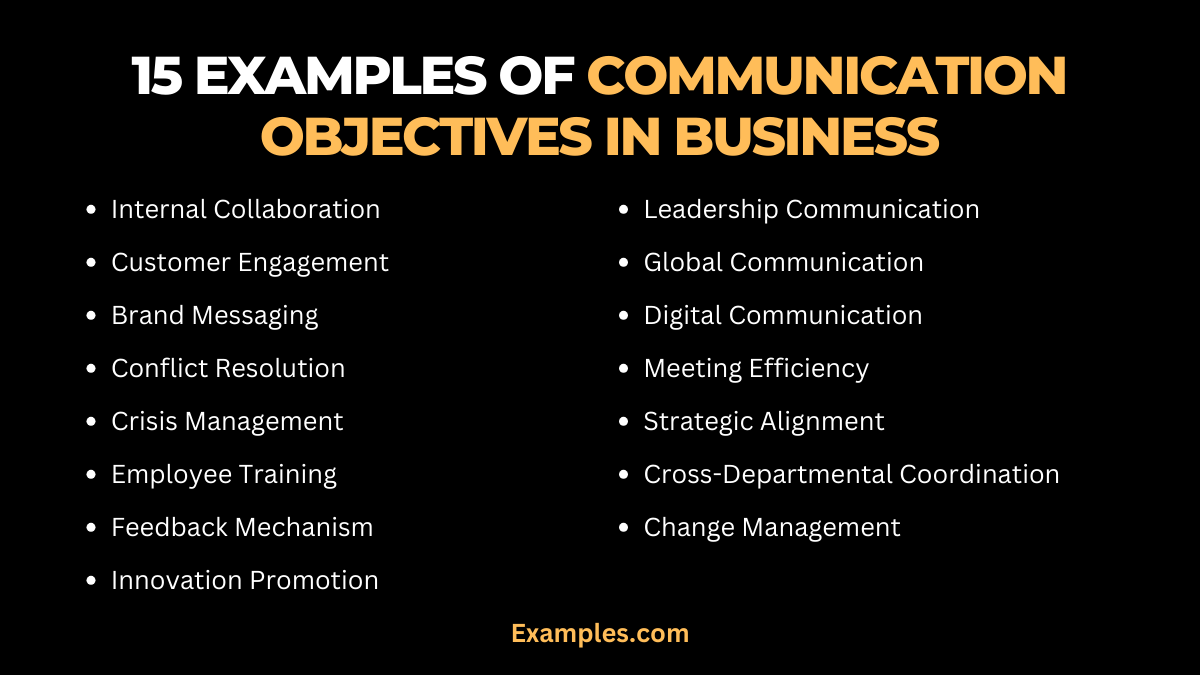Communication Objectives in Business
Unlock the gateway to business success with our comprehensive guide on Communication Objectives in Business. Dive into the intricacies of effective communication, exploring key objectives and their strategic impact. Discover real-world Communication Examples that illustrate successful practices, ensuring you master the art of business communication. Elevate your corporate game, refine your strategies, and achieve optimal results in the dynamic world of business interactions.
What are the Communication Objectives in Business

Communication objectives in business refer to specific, measurable goals set to enhance organizational communication. These objectives aim to improve internal and external communication processes, fostering clarity, collaboration, and overall efficiency. By aligning communication strategies with business goals, companies can ensure effective information flow, employee engagement, and external relations, contributing to sustained success and growth.
15 Examples of Communication Objectives in Business
Effective communication in business involves clear objectives. Improve team collaboration, customer relations, and brand positioning through strategic communication planning. Achieve transparency, trust, and operational excellence with well-defined communication objectives.

- Internal Collaboration: Establish regular team meetings to enhance intra-team communication.
- Customer Engagement: Implement targeted email campaigns for personalized client interactions.
- Brand Messaging: Craft a compelling mission statement for consistent external communication.
- Conflict Resolution: Develop a protocol for addressing conflicts promptly and constructively.
- Crisis Management: Create a crisis communication plan to address unforeseen challenges.
- Employee Training: Use interactive workshops to enhance communication skills among staff.
- Feedback Mechanism: Implement regular surveys to gather employee and customer feedback.
- Innovation Promotion: Encourage idea-sharing platforms for fostering creativity.
- Leadership Communication: Ensure leaders maintain an open-door policy for effective communication.
- Global Communication: Implement multilingual communication strategies for diverse audiences.
- Digital Communication: Leverage social media for real-time updates and customer engagement.
- Meeting Efficiency: Optimize meeting protocols to enhance time and information management.
- Strategic Alignment: Align communication with business goals for cohesive messaging.
- Cross-Departmental Coordination: Facilitate communication channels between different departments.
- Change Management: Communicate changes transparently, addressing concerns proactively.
Communication Objectives in Business at Work
Effective communication at the workplace is crucial for productivity and collaboration. Clear objectives enhance teamwork, boost morale, and ensure everyone is aligned with organizational goals.
- Task Delegation: Clearly convey responsibilities to team members for seamless execution.
- Performance Feedback: Provide constructive feedback to employees for continuous improvement.
- Project Updates: Regularly communicate project progress and milestones to stakeholders.
- Meeting Efficiency: Optimize meetings for concise and impactful discussions.
- Conflict Resolution: Address and resolve workplace conflicts promptly and diplomatically.
- Employee Recognition: Acknowledge and appreciate individual and team achievements.
- Policy Communication: Effectively communicate company policies and updates.
- Training Initiatives: Clearly outline training objectives for skill development.
- Cross-Team Collaboration: Foster collaboration between different teams for integrated efforts.
- Wellness Programs: Communicate wellness initiatives to promote employee well-being.
What is Communication and Its Objectives in Business?
Communication in business involves the exchange of information, ideas, and feedback to facilitate effective collaboration and decision-making. The objectives of communication in a business setting are multifaceted, aiming to achieve clarity, alignment, and successful outcomes.
- Clarity and Understanding:
- Ensure messages are clear, concise, and easily comprehensible.
- Minimize ambiguity to prevent misunderstandings among stakeholders.
- Alignment with Organizational Goals:
- Communicate information that aligns with the overarching objectives of the business.
- Foster a shared understanding of the company’s vision and mission.
- Employee Engagement and Morale:
- Promote open and transparent communication to engage and motivate employees.
- Address concerns promptly to maintain a positive work environment.
- Effective Decision-Making:
- Facilitate the flow of information necessary for informed decision-making.
- Ensure key decision-makers have access to relevant data and insights.
- Conflict Resolution:
- Establish channels for resolving conflicts professionally and efficiently.
- Encourage open dialogue to address disputes and maintain a harmonious workplace.
- Customer Relations:
- Communicate effectively with customers to understand their needs.
- Build trust and loyalty through clear and responsive communication.
- Innovation and Creativity:
- Encourage a culture of innovation through open communication channels.
- Facilitate idea-sharing and collaboration to drive continuous improvement.
Why is Communication Important in Business?
Effective communication is the lifeblood of successful businesses, playing a pivotal role in various aspects of organizational functioning. Understanding the significance of communication in business is crucial for fostering growth, building strong relationships, and achieving sustainable success.
- Enhanced Collaboration:
- Encourages teamwork and collaboration among employees and teams.
- Fosters an environment where diverse skills and perspectives contribute to shared goals.
- Strategic Alignment:
- Ensures that all stakeholders are aligned with the company’s strategic objectives.
- Facilitates the implementation of business plans with unified effort.
- Increased Productivity:
- Reduces misunderstandings and inefficiencies, leading to improved productivity.
- Streamlines processes through clear communication of roles and responsibilities.
- Customer Satisfaction:
- Builds positive relationships with customers through effective communication.
- Addresses customer queries and concerns promptly, enhancing satisfaction.
- Adaptability to Change:
- Facilitates smooth transitions during periods of change or organizational growth.
- Keeps employees informed and engaged, minimizing resistance to change.
- Risk Mitigation:
- Reduces the risk of errors and misunderstandings that can lead to financial or reputational damage.
- Promotes transparency and accountability in business operations.
- Leadership Effectiveness:
- Enables leaders to convey their vision and expectations clearly.
- Strengthens leadership effectiveness by fostering trust and credibility.
In conclusion, mastering communication objectives in business is pivotal for organizational success. From fostering collaboration to enhancing customer relations, effective communication aligns teams, drives innovation, and ensures strategic clarity. Embracing clear objectives empowers businesses to navigate challenges, adapt to change, and build lasting connections, ultimately shaping a resilient and thriving enterprise. Explore the comprehensive guide and examples provided to elevate your business communication strategies.



